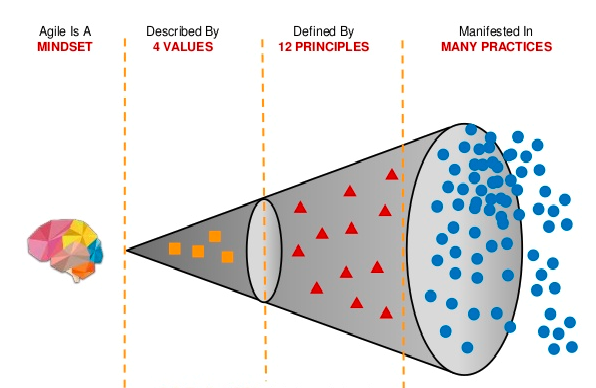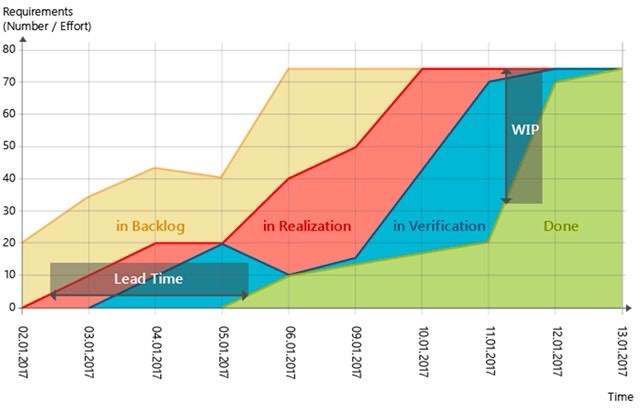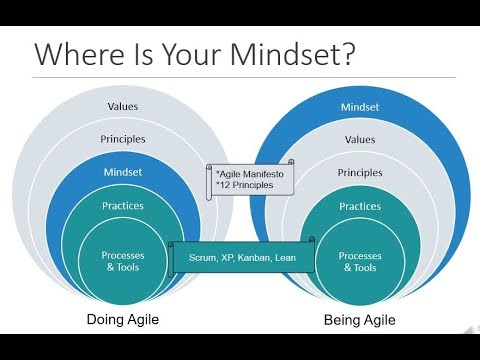Agile Mindset -: Understanding principles before leading

Introduction
A mindset, or state of mind, is a set of beliefs, thoughts, biases, assumptions and values held by an individual or a group of individuals that leads the individual or the group respectively towards the choices they make. The Humans are most comfortable in choosing paths or making decisions that confirm with their beliefs, assumptions, biases and values. The existing mindset is made up of all these and rewards itself through positive reinforcement by guiding the individual or the group, in case of shared mindset, towards the path of least struggle. In other words, towards the path that is in conformance with the existing set of beliefs, thoughts, biases, assumptions and values. Simply put, it is a way of thinking about things and making decisions that those in a group share to the point that it becomes a way of life.
Flowing from the above definition, an Agile mindset can be defined as set of beliefs, thoughts, biases, assumptions and values that guide individuals and group members to make each decision to support an Agile way of working, or Agile work environment. Agile work environment at a broad level is made up of focus on collaboration, team work, flexibility to change, respect, communication, client-partnership, continuous feedback loop, learning cycle and fearlessness towards failures.
Lets not be fooled by the simplicity of the above terms. It is easier to define mindset and then attach Agile to it, or better still, define Agile terms around what should be done, or the ideal way. In real world however, most people and teams practicing Agile struggle to understand or explain to others what constitutes an Agile mindset. Most of the times people hide behind thinly veiled excuses like, ‘Oh, I get it, but cannot explain it to others.’

Drivers of Agile mindset
The Agile mindset is the environment within which agile teams have their brightest chance to flourish. It is not laid out anywhere. It isn’t a prerequisite for an agile adoption, nor is it a standard which can be adapted for a functional agile team. This mindset is simply the best foundation on which Agile teams can propel themselves to success.
Specifically, an agile mindset is powered by 3 primary measures. First, an agile mindset always encourages early adaptation of Agile principles. Second step is continuous reinforcement and retention, while the third step is measuring metrics and driving compliance in day to day working environment and fine tuning approach as necessary. These three practices – adaptation, continuous reinforcement and retention and measurement of metrics are the key in any organization’s Agile journey.
Many enterprises begin their Agile journey with noble intentions. They want to improve their product offering to customers, improve their go-to-market or turnaround times, bring in internal efficiencies, reduce time between deployments, or all of these. However it’s quite common for many of Agile adapters to discover that they are not fully prepared for the Agile journey. This could happen due to one or combination of many factors. They may discover that employees do not fully understand Agile and any efforts to have them adapt Agile have not been fully successful. Or that the internal environment is not conducive for Agile way of working. This would primarily happen if one or more of key stakeholders or top level management is not a believer of benefits of Agile. In most cases however Agile adaptions fail because the organization tries to do too much in too little time. One of the great failure points of Agile is that Agile is not a magic wand. One cannot hope to implement few Agile practices or principles and expect overnight improvement. And when the improvements don’t come about, blame it on Agile. Agile is not a magic cure for years of inefficiencies or layers of bureaucracy in the organization or half-hearted efforts at implementation. Above all, Agile requires discipline and effort to commit to Agile principles and stay committed even in the face of less than expected benefits. In order to reap true benefits of Agile, it takes sustained and repeated training, high management focus, reinforcements and continuous practice of Agile principles. Remember: Agile is only as good as the people implementing it. So if you notice Agile is failing in your organization, guess what! Chances are something else is failing too.
Adaption of Agile methods is perhaps the easiest step. All it takes is starting implementation of Agile principles and the practices as per the chosen method. However, this is an inherent weak point as the adaptation needs to be accompanied with strong commitment as any halfhearted attempt will lead to disappointment.
The second most important aspect is continuous reinforcement and retention of Agile principles. Adapting agile in a Big Bang manner or as a quiet change is not worth much if not followed up with regular reinforcements through trainings, refreshers, communications and word of mouth messages. The Agile principles and practices need to be driven deep down to the deepest layers through untiring, unrelenting efforts by professionals like Agile coaches and leaders. Agile roles need to be strengthened and given enough autonomy to run things on the ground. Agile coaches must drive and ensure adherence to all Agile practices and ceremonies as per the chosen method. Above all, Agile must be made a part of, promoted and practiced as a ‘way of working’ and not as a special endeavor or initiative.
Whatever is the chosen method of Agile implementation– Scrum, scaled scrum, kanban, Lean or any other, the Agile coaches need to take the mantle of driving Agile principles. Constant reiterating is just one part of the journey. Teams and individuals must be constantly evaluated on their individual compliance with Agile principles and ceremonies depending on the chosen method. Individuals and teams lagging behind must be coached on the benefits of Agile and helped in order to bring them up to expectations. Remember: Agile adaptation is a disciplined team effort and reinforcement at individual and team level is necessary to enforce rigor.
And this brings us to the third part, specifically around measurement of metrics. Maintenance and adherence to product backlog, prioritizing sprint backlog, tracking efforts burned down and remaining during sprints, user stories closed and accepted by customer, are some of the metrics.
- Sprint burn-down -: The sprint burn-down chart visualizes how many story points have been completed during the sprint and how many remain, and helps forecast if the sprint scope will be completed on time.
- Lead time -: Lead time measures the total time from the moment a story enters the system (in the backlog), until it is completed as part of a sprint, or released to customers. It measures the total time for a requirement to be realized and start earning value – the speed of your value chain.
- Agile velocity-: Velocity measures how many story points were completed by a team, on average, over the past few sprints. It can be used to predict the team’s output in the upcoming sprints.
- Code coverage -: Code coverage measures the percentage of your code which is covered by unit tests. It can be measured by the number of methods, statements, branches or conditions which are executed as part of a unit test suite.
- Cumulative flow -: Cumulative flow is a kanban metric which shows the status of tasks – in a sprint, a release or across software teams. It can visualize bottlenecks in the process – a disproportionately large number of tasks in any of the workflow stages indicates a problem. For example, a big “bubble” in the chart in a verification or testing stage indicates this stage has insufficient resources.

Image credit : Microtools
- Failed deployments -: Measures the number of deployments (either to test, production environments, or both). Can help understand how solid environments are and whether teams are really building potentially shippable software.
Conclusion
Perhaps, what makes Agile difficult for lot of managers to grasp is that it’s not just a technology, methodology or process that gets implemented within an enterprise’s current culture and assumptions. The Agile way of running an organization seeks to fundamentally redefine the very concept of an enterprise which has prevailed for the last one hundred years.
Instead of an enterprise being conceived as an efficient, profitable steady-state machine aimed at exploiting its environment and existing business model and the industry its part of, the Agile organization is a growing, learning, adapting living organism that is in constant flux to exploit new opportunities and add new value for customers.
